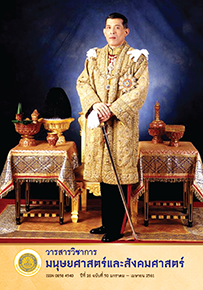อิทธิพลของชนิดบทความต่อความเข้าใจในการอ่านบทความภาษาฝรั่งเศส Influence of Article Types on Reading Comprehension in French
Main Article Content
Abstract
งานวิจัยชิ้นนี้มีจุดประสงค์เพื่อศึกษาความสามารถของผู้เรียนภาษาฝรั่งเศสชาวไทยในระดับอุดมศึกษาที่มีความรู้ในระดับ B1-B2 ในการอ่านบทความภาษาฝรั่งเศสชนิดเชิงอภิปราย (Texte argumentatif) และชนิดให้ความรู้ (Texte informatif) การวิเคราะห์แยกออกเป็น 2 ประเด็น คือ ความสามารถในการแยกชนิดบทความ และอิทธิพลของชนิดบทความที่มีต่อความเข้าใจของผู้เรียนเพราะรูปแบบการเขียนหรือวิธีการนำเสนอข้อมูลในบทความแต่ละชนิด (Types) แตกต่างกันดังนั้น คณะผู้วิจัยจึงทำการทดลองโดยให้ผู้เรียนอ่านบทความทั้ง 2ชนิดนี้ อย่างละ2 บทความ รวม 4 เรื่องด้วยกัน และทำแบบฝึกหัดวัดความเข้าใจเพื่อศึกษาว่าผู้เรียนสามารถเข้าใจบทความชนิดใดได้มากกว่ากัน และทำการสัมภาษณ์เพื่อศึกษาความสามารถในการแยกชนิดบทความพร้อมทั้งศึกษาความคิดเห็นของผู้เรียนเกี่ยวกับอิทธิพลของชนิดบทความต่อความเข้าใจบทความ ซึ่งผลการวิเคราะห์ชี้ให้เห็นว่าชนิดของบทความมีผลต่อแรงจูงใจในการเลือกอ่านบทความ โดยผู้เรียนส่วนใหญ่เลือกอ่านบทความเชิงอภิปราย เพราะมีการนำเสนอแนวคิดที่หลากหลายและคิดว่าบทความให้ข้อมูล เป็นการให้ความคิดด้านเดียว และมีลักษณะเป็นบทความวิชาการทำให้อยากอ่านน้อยลง แต่ผลการทำแบบฝึกหัดวัดความเข้าใจบ่งบอกว่าชนิดของบทความไม่มีผลต่อระดับความเข้าใจ เพราะผู้เรียนสามารถทำแบบฝึกหัดได้คะแนนในระดับที่เท่ากัน
This research aimed to study ability of Thai tertiary level learners of French with B1-B2 reading levels for argumentative and informative articles. The analysis method used in this research focused on 2 main points: ability to differentiate article types, and influence of article types on learners’comprehension. This is because writing or presentation styles of each article type are different. Therefore, the research team conducted an experiment by having learners read both of the article types twice, the total of 4 stories. To examine which article type the learners could comprehend better, they were also asked to do the comprehension exercises. Interviews were conducted to study ability to differentiate article types and to study opinions of the learners about the influence of article types on comprehension of the articles. The analytical findings indicated that article types resulted in motivation to select an article to read. Most learners selected argumentative articles because of various conceptual presentation styles. This made such reading interesting. The learners thought that informative articles were one-sided. Characteristics of these articles were also academic; thus, the learners were less preferred them. However, results of the comprehension exercises of the 4 articles indicated that article types did not affect the comprehension level because the learners were able to gain a score of the same level from the exercises.
Downloads
Article Details
บทความทุกบทความเป็นลิขสิทธิ์ของวารสารวิชาการมนุษยศาสตร์และสังคมศาสตร์ มหาวิทยาลัยบูรพาเท่านั้น
References
Adam, J.M. (2017). Les textes : types et prototypes (4ème édition). Paris: Armand Colin.
Beacco, J.-C. (2007). L'approche par compétences dans l'enseignement des langues: Enseigner à partir du Cadre
européen commun de référence pour les langues. Paris: Didier.
Beacco di Giura, M. et Beacco, J.-C. (2009). Alors ? Niveau B1: Méthode de français fondée Sur l'approche par compétences. Paris: Didier.
Castellotti, V. (2017). Pour une didactique de l’appropriation, diversité, compréhension, relation. Paris : Didier.
Coirier, P. (1991). Production of argumentative discourse: the textual function of statements considered important by
the speaker. Advances in Psychology, vol.79, 363-374.
Combettes, B. et Tomassone, R. (1988). Le texte informatif. Bruxelle : De Boeck
Cuq, J.-P. (2003). Dictionnaire de didactique du français langue étrangère et seconde. Paris: CLE international
Cuq, J.-P. et Gruca, I. (2008). Cours de didactique du français langue étrangère et seconde. Grenoble: Presse
universitaire de Grenoble.
Dollez, C. & Pons, S. (2007). Alter ego 4 : Méthode de français. Paris: Hachette.
Falarddeau, E. (2003). Compréhension et interprétation: deux composantes complémentaires de la lecture littéraire,
Revue des sciences de l’éducation, vol 29, 673-694
Fonvielle, S. et Pellat, J.-C.(2016). Le Grevisse de l’enseignant. Paris: MARNARD
Giasson, J. (2011). La compréhension en lecture. Bruxelles: De Boeck.
Le Ley, Y. (2009). Savoir rédiger. Paris: Larousse.
Pellat, J.-C., Riegel, M. et Rioul, R. (2012).Grammaire méthodique du français. Paris: Presses Universitaires de
France.
Robert, J.-P. (2008). Dictionnaire pratique de didactique du FLE. Paris: Editions Ophrys.
Siouffi, G. et Raemdonck, D.V. (2012). 100 fiches pour comprendre la linguistique. Paris: Bréal.
Tauveron, C. (1999). Comprendre et interpréter le littéraire à l’école: du texte réticent au texte proliférant, Repères,
vol. 10, 9-38.
Vanderdorpe, C. (1992). Comprendre et interpréter. In C. Préfontaine et M. Lebrun (dir.), La lecture et l’écriture.
Enseignement et apprentissage, Montréal: Les Editions logiques, 159-182.
สิรจิตต์ เดชอมรชัย. (2013). การสอนภาษาฝรั่งเศสในฐานะภาษาต่างประเทศ แนวคิดและวิธีการ. กรุงเทพฯ: โรงพิมพ์แห่งจุฬาลงกรณ์มหาวิทยาลัย.


